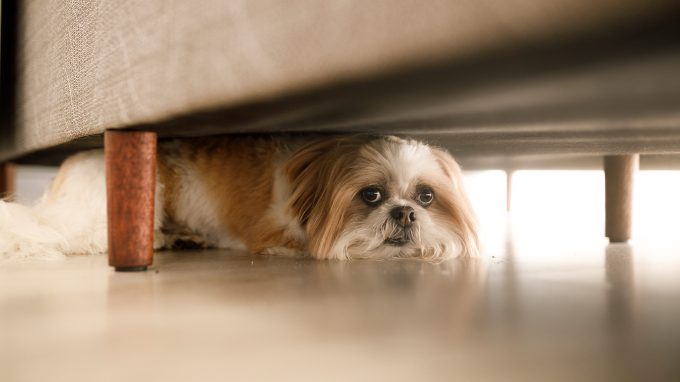
A fearful dog can miss out on fun activities with other pets and people, hide from new situations, and cause extra anxiety and stress. But, what causes fearfulness in dogs, and how can you help? Learn more about fearfulness in dogs, the reasons behind it, and the steps to take to reduce your dog’s stress.
Why are some dogs fearful?
Dogs can become fearful for several reasons; namely genetics, trauma, and socialization issues. Some breeds are naturally shy, such as toy breeds like Chihuahuas, Pekingese, and Maltese. Dog breeds created for protection or livestock guardianship such as Akitas and Great Pyrenees may also be naturally wary of others.
Trauma and socialization issues, however, are the largest factors behind fearfulness in dogs. If you’ve recently rescued a dog with a history of trauma, they may associate certain people or situations with a bad experience. Poor socialization can cause a similar fearful response. However, with socialization the root cause is a lack of exposure to various situations rather than a reaction to them.
What does fearfulness in dogs look like?
Fear in dogs can manifest in many ways — and it varies depending on the dog. Most dogs follow the “fight or flight” response, and some will even show a “freeze” response when confronted with a fearful situation. Dogs exhibiting the flight response will often try to avoid or remove themselves from the situation. They may tuck their tails, hunch their body to look smaller, whimper or cry out, and run and hide. You may spot them under the bed, in the bathtub, or away in a dark room.
Dogs that have the freeze response will completely clam up when confronted with a fearful situation. You may notice wide, saucer-like eyes, excessive yawning, a tucked tail, hunched body, and your dog may urinate or cry out. Lastly, dogs that have a fight response may act aggressively when faced with a fearful situation. They may growl, hackle, and focus their attention on the person or thing causing fear. A very fearful dog may also nip or bite hard enough to cause injury.
Tips to help a fearful dog
Luckily, there are steps you can take to help a fearful dog. If your dog’s fear manifests as aggression, it is best to seek out the advice of a veterinary behaviorist in your area. Aggression can cause harm to other people or pets and should always be worked with under professional supervision.
For dogs dealing with trauma or a lack of socialization, training classes and help from a trainer can also be useful. They can work with you to start a plan of gradually desensitizing your dog to the fearful situation. This is often through a training technique called Behavioral Adjustment Training (BAT). This helps dogs get used to scary things by slowly acclimating over time — with lots of positive rewards.
At home, you can employ some similar training techniques. You’ll want to start turning scary situations into positive ones by associating people and places with good things instead of bad. If your dog is afraid of new people, have a person toss them a treat every time they come to visit (without further interaction). If your dog is fearful of a location, you can spend a few minutes in that area, giving a stream of treats and praise the entire time.
If at any time your dog shows signs of fear or discomfort, stop the training and take a break. Don’t push your dog to continue as this may reinforce the fear response instead of the positive one. You can try again at a later time.
Fearfulness in dogs can be a frustrating experience with many causes. But, training, persistence, and a lot of love can help your dog settle into a happier, fear-free life.









